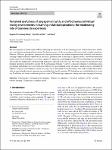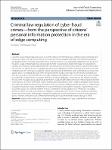Search
Author
- Jorgensen, Ed (3)
- McFadyen, Ron (3)
- Nora, El-Rashidy (3)
- Christian, Homeyer (2)
- next >
Subject
- programming (10)
- Open Access (8)
- Java (7)
- Programming (7)
- next >
Date issued
- 2020 - 2025 (293)
- 2010 - 2019 (39)
- 2000 - 2009 (2)
- 1999 - 1999 (1)
Has File(s)
- true (335)
Search Results
Oral implantology is a science in constant evolution, with a considerable number of articles being published every year in scientific journals. Publications can be analyzed through bibliometric analysis, thus observing the evolution and trends of the articles published in the journal. To evaluate, through bibliometric analysis, the scientific production of Clinical Implant Dentistry and Related Research (CIDRR) and its evolution and trends in the last 5 years (2016–2020).All articles published in CIDRR in the last 5 years were reviewed and classified according to the year of publication, volume, number, the number of authors, demographic data of the first and last author, the geographical scope of the article, the number of affiliations of the authors, research topic, type of study,... |
To evaluate the security of a cryptographic primitive, investigating its resistance against differential and linear cryptanalysis is required. Many modern cryptographic primitives repeatedly apply similar round functions alternated with the addition of round keys or constants. A round function usually consists of a non-linear mapping and a number of linear mappings. The non-linear mapping χ is used in different cryptographic primitives such as KECCAK and SUBTERRANEAN. An alternative version of χ is used in ASCON and the non-linear layer of SIMON has the same differential and linear properties of χ. The mapping χ can be applied to strings with different lengths. |
The development of virtual reality (VR) in enhancing the effectiveness of the learning process, with its interactive, immersive, and intuitive pedagogical environment, has become a necessity for corporations with increasingly complex operations. However, VR users’ perceptions, openness and learning effectiveness are seldom comprehensively evaluated, particularly in learning complex industrial operations. In this study, grounded in the technology acceptance model, a moderated mediation model of perceived usefulness, ease of use, openness to experience, and engagement in VR-based learning was developed. The model was empirically validated using responses collected from 321 users who were trained on aircraft and cargo terminal operations powered by a novel VR-based learning platform. |
Currently, cloud computing provides users all over the globe with Information and Communication Technology facilities that are utility-oriented. This technology is trying to drive the development of data center design by designing and building them as networks of cloud machines, enabling users to access and run the application from any part of the globe. Cloud computing provides considerable benefits to organizations by providing rapid and adaptable ICT software and hardware systems, allowing them to concentrate on creating innovative business values for the facilities they provide. |
This open access book provides a state-of-the-art overview of current machine learning research and its exploitation in various application areas. It has become apparent that the deep integration of artificial intelligence (AI) methods in products and services is essential for companies to stay competitive. The use of AI allows large volumes of data to be analyzed, patterns and trends to be identified, and well-founded decisions to be made on an informative basis. It also enables the optimization of workflows, the automation of processes and the development of new services, thus creating potential for new business models and significant competitive advantages.
The book is divided in two main parts: First, in a theoretically oriented part, various AI/ML-related approaches like aut... |
This open access book explains the state of the art in quantum software engineering and design, independent from a specific hardware. It deals with quantum software theoretical aspects and with classical software engineering concepts like agile development approaches, validation, measurement, and deployment applied in a quantum or hybrid environment, and is complemented by a number of various industry applications.
After an introductory chapter overviewing the contents of the subsequent chapters, the book is composed of three parts. It starts with a theoretical part on quantum software, as a bold declaration that quantum software theory is deep and valuable independent from the existence of specific quantum hardware. It is based upon the claim that quantum software is the more ge... |
This open access book explores the recent developments automated driving and Car2x-communications are opening up attractive opportunities future mobility. The DFG priority program “Cooperatively Interacting Automobiles” has focused on the scientific foundations for communication-based automated cooperativity in traffic.
Communication among traffic participants allows for safe and convenient traffic that will emerge in swarm like flow. This book investigates requirements for a cooperative transport system, motion generation that is safe and effective and yields social acceptance by all road users, as well as appropriate system architectures and robust cooperative cognition.
For many years, traffic will not be fully automated, but automated vehicles share their space with manu... |
This open access book presents a comprehensive guide to MATLAB programming, catering to students, engineers, and researchers seeking to harness MATLAB as a powerful tool for their work. The text meticulously covers fundamental concepts, progressing from basic elements such as types and operators to more complex structures like arrays and matrices. It elucidates key programming constructs including selection statements, loop structures, scripts, and functions, providing readers with a solid foundation in MATLAB programming.
The book's structure is carefully crafted to facilitate step-by-step learning, with each chapter building upon previous knowledge. Abundant examples and exercises reinforce understanding, while dedicated sections on data visualisation, algorithm development, an... |
This open access book presents the concept of Informed Machine Learning and demonstrates its practical use with a compelling collection of applications of this paradigm in industrial and business use cases. These range from health care over manufacturing and material science to more advanced combinations with deep learning, say, in the form of physical informed neural networks. The book is intended for those interested in modern informed machine learning for a wide range of practical applications where the aspect of small data sets is a challenge.
Machine Learning with small amounts of data? After the recent success of Artificial Intelligence based on training with massive amounts of data, this idea may sound exotic. However, it addresses crucial needs of practitioners in industr... |
This open access book provides cybersecurity practitioners with the knowledge needed to understand the risks of the increased availability of powerful large language models (LLMs) and how they can be mitigated. It attempts to outrun the malicious attackers by anticipating what they could do. It also alerts LLM developers to understand their work's risks for cybersecurity and provides them with tools to mitigate those risks.
The book starts in Part I with a general introduction to LLMs and their main application areas. Part II collects a description of the most salient threats LLMs represent in cybersecurity, be they as tools for cybercriminals or as novel attack surfaces if integrated into existing software. Part III focuses on attempting to forecast the exposure and the developm... |










